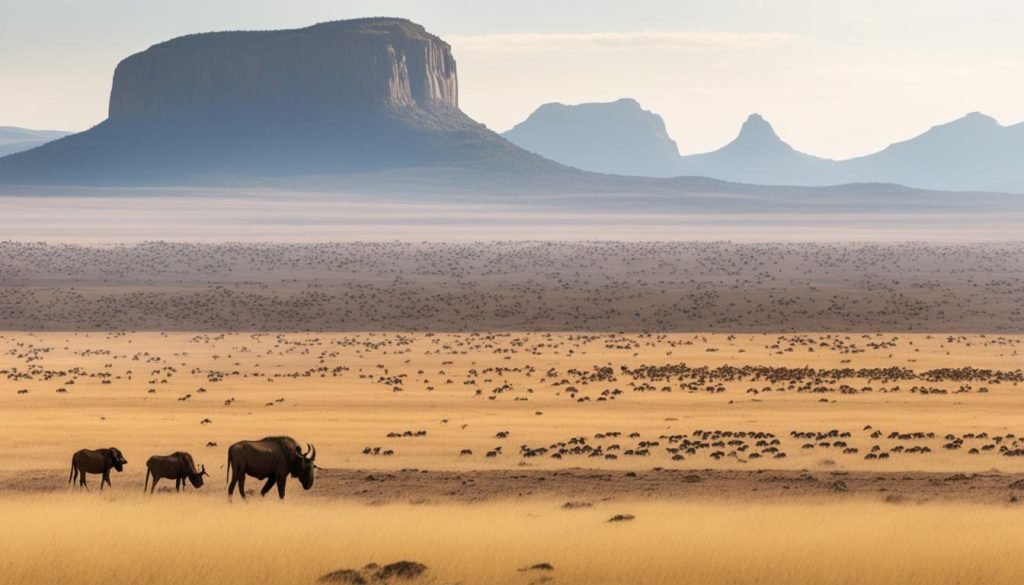The film “Dawn of Humanity” takes us way back in time. It uncovers prehistoric findings that teach us about where humans come from. In 2013, scientists found the fossil remains of Homo naledi in South Africa’s Rising Star Cave.
This was a big discovery. It gave us a lot of information about our ancient relatives and how they lived.
Scientists dug up old tools and bones with care. These ancient items tell us a lot about our evolution and our early days.
They show us what life was like for our ancestors. This includes their beliefs and even their art.
Key Takeaways:
- Archaeological discoveries and paleontological excavations have unearthed prehistoric artifacts and fossil remains that shed light on human origins.
- Understanding the significance of these findings helps us piece together the story of human evolution and our ancient past.
- The discovery and excavation of Homo naledi’s fossil remains in South Africa have provided valuable information about an extinct species of hominin.
- Prehistoric artifacts offer insights into the daily lives, beliefs, and artistic expressions of our ancient ancestors.
- Cultural practices, such as ancestor worship, can be traced back to prehistoric times through archaeological evidence.
Unearthing the History: Exploring Prehistoric Artifacts
Prehistoric artifacts show us what life was like for our ancient family. They include cave paintings and tools. These items tell us how early people lived and what they believed.
Archaeologists find many things, like stone tools, pottery, and art in caves. These treasures offer a deeper view into our past. They teach us about human history and our journey through time.
Learning about prehistoric relics shows us how smart and creative early people were. Stone tools connect us to the past. They demonstrate early humans’ innovative problem-solving. These tools also reflect their daily practices and beliefs.
Stone Tools: Traces of Ancient Innovation
Among the most common prehistoric items are stone tools. These show the cleverness of our early ancestors. They crafted tools from materials like flint, obsidian, and chert. This demonstrates their ability to use what they found for survival.
“The study of prehistoric artifacts is like piecing together an ancient puzzle. Each artifact tells a story, offering insights into the lives and legacy of our ancestors. The traces of antiquity hold the key to understanding our cultural heritage and the remarkable journey of human evolution.” – Dr. Emma Spencer, Archaeologist
Ancient Art: A Window Into Prehistoric Culture
Prehistoric art in caves shows us ancient life and beliefs. The scenes of hunting and mythological figures are inspiring. They showcase early humans’ creativity and story-telling.
The Lascaux Cave in France is a famous site of ancient art. It contains art over 17,000 years old. The images reveal much about ancient spiritual and cultural practices.
Preservation Challenges and Cultural Impact
It’s crucial to protect our ancient heritage. Prehistoric items are fragile and face decay. Many experts work to preserve these important relics. They use new methods to keep these remnants for future study.
Studying prehistoric artifacts changes how we see our history and culture. These treasures provide insight into our shared past. They illustrate the remarkable creativity and resilience of ancient peoples.
The Fossil Record: Clues to Human Evolution
The fossil record helps solve mysteries of human evolution. Scientists find ancient remains in digs. These fossils are bridges to our past, showing the journey of Homo sapiens.
Experts closely study these remains. They trace our species’ path and the growth of human traits. Through these finds, we better understand our evolution and the forces that molded us.
Uncovering the Secrets of the Past
Fossil finds in digs tell an engaging tale. From hominin skeletons to ancient footprints, each discovery deepens our history.
“The fossil record provides us with a unique window into the distant past, allowing us to see our ancestors and understand their journey through time.” – Dr. Jane Wilson, Paleontologist
These ancient clues show physical changes over years. They help prove how we started walking upright, grew smarter, and began using symbols.
The Significance of Fossil Discoveries
Every fossil find is a glimpse into our past. By studying them, scientists learn about our ancestors’ lives. They can tell what they ate, how they behaved, and where they lived.
Pairing genetic and fossil studies helps map the human family tree. It shows us our common ancestors and how early humans spread around the world.
Pioneering Discoveries in Paleontology
Many paleontologists have changed human history understanding. For instance, Mary Leakey found early hominins in East Africa. Richard Leakey proved our African origins.
As digging for fossils continues, we’ll learn even more. These discoveries offer deeper insights into our past and evolution.

African Origins: The Birthplace of Humanity
Discoveries in Ethiopia show strong evidence for the Out of Africa idea. This states that Homo sapiens started in Africa. These ancient skulls, found from 160,000 years ago, are a key part of our human story. They back up the thought that we began in Africa and later spread.
For a long time, we’ve known Africa to be the place where humans first appeared. These findings in Ethiopia make this belief even stronger. The fossils offer a glimpse into our beginnings in Africa, giving us clues about our path.
Out of Africa Hypothesis
The Out of Africa hypothesis proposes that Homo sapiens originated in Africa and subsequently migrated to other parts of the world.
This idea says we came from Africa and moved across the world. As we did, we replaced other species of hominins. Many types of evidence, like genetic research and finding fossils, support the Out of Africa idea.
In Ethiopia, the skull fossils were found, linking back thousands of years. They are direct proof of ancient people in Africa. They play a big part in understanding where we come from and how we became what we are today.
A Significance of African Origins
Seeing Africa as our beginning is very important. It tells us a lot about our story, showing the strength and creativity of our first people. The roots of African cultures and traditions go very deep because of this history.

| advantages of African Origins | implications of African Origins |
|---|---|
| African origins lend credence to the significance of diversity within the human species. | The Out of Africa hypothesis challenges notions of separate, parallel evolution in different regions. |
| African origins emphasize the importance of Africa in the study of human evolution and anthropology. | Understanding African origins can bridge cultural divides and foster a greater sense of shared humanity. |
| African origins contribute to our understanding of migrations, global population dispersal, and the development of human societies. | The prehistoric findings in Africa provide valuable insights into early human behaviors and adaptations. |
Africa being the birthplace of humanity opens up a colorful history. By exploring and respecting our African beginnings, we learn about the ties that connect us all. This is regardless of where we now live.
Cultural Significance: Ancestor Worship and Rituals
Prehistoric findings show us how our ancient ancestors lived. They include modified skulls and signs of ancestor worship. These show early humans were highly cultured.
Early communities cared deeply for their ancestors. They held rituals to honor their past. This maintained a strong link to their history.
Learning about ancient rituals helps us understand our ancestors’ beliefs. These rituals brought people together and passed down culture. They were important for community unity.
Archaeologists learn a lot from studying ancient rituals. They discover the depth of human culture and our ancestors’ efforts to understand the world.
“Ancestor worship was key for honoring the past and feeling connected in the community.”
Discoveries like modified skulls suggest ancient practices had deep meaning. These cultural aspects were important for ancestor worship. They were a big part of early societies’ rituals.
Rituals were a way for early humans to listen to their ancestors. These ceremonies linked the living with those who had passed. They showed the strong connection between generations.
Studying ancestor worship informs us about ancient social and spiritual life. These insights are key to understanding early human culture and the value of remembering our ancestors.
The Legacy of Ancestor Worship
Today, we still see the practice of honoring the past. This includes memorial services, visiting graves, and keeping traditions alive.
Remembering our ancestors is important. It shows gratitude and keeps their wisdom alive. Ancestor worship helps us know who we are.
Exploring ancient rituals uncovers a rich cultural history. It shows the beauty of human traditions and our deep need to respect our ancestors.
Conclusion
Prehistoric findings are key in learning about our past. They help us see how we’ve evolved and what our ancestors did.
Scientists study remains our ancient relatives left behind. They learn from fossils, tools, and cave art. These discoveries show us how early humans lived and what they believed.
Fossil evidence teaches us about human evolution. It shows our development over time. By studying these clues, scientists keep uncovering our species’ history.
These findings are not just scientific but also culturally important. They show that early humans had advanced rituals. This reminds us about the importance of our past and the traditions we share.



